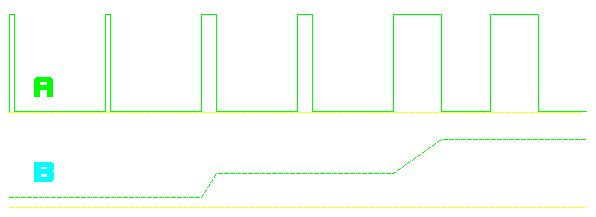 |
|
CLASS 'D' We said that class 'A' amplifiers were VERY inefficient. Class 'AB' amplifiers are also inefficient but are more more efficient than class 'A' amplifiers. Class 'AB' mobile amplifiers are generally 60% efficient when driving a 4 ohm load at maximum power (just before clipping). The reason that these amplifier configurations are inefficient is because there is a difference of potential (voltage) across the output transistors and current flowing through the output transistors. When you have voltage across the device and current flow through the device, there will be power dissipation in the form of heat. The power needed to produce this heat is wasted power. When there is (virtually) no voltage drop across a device (such as a large piece of wire or a transistor), there can be a significant amount of CURRENT flow through the device with (virtually) no power dissipation. This means that there is virtually no heat given off (highly efficient). The inverse is also true. If you have a significant amount of VOLTAGE across the device (transistor, wire...) but no current flow through the device, again, there will be no wasted power. OK, now to the point. A class 'D' amplifier, which may also be known as a switching amplifier or a digital amplifier, utilizes output transistors which are either completely turned on or completely turned off (they're operating in switch mode). This means that when the transistors are conducting (switched on) there is virtually no voltage across the transistor and when there is a significant voltage across the transistor (switched off), there is no current flowing through the transistor. This is very similar to the operation of a switching power supply which is very efficient. Output transistor switching: In the diagram below, there are 3 waveforms. Point 'X' is the point where the transistor would be fully 'on', it would be conducting the full power supply voltage.This is the same as taking a piece of wire and connected the rail voltage to the speaker output of the amplifier. Point 'Y' shows that the transistor is fully 'off' and the output voltage is effectively 0 volts. This is the same as completely disconnecting the speaker from the amplifier. The 'duty cycle' of waveform 'A' is approximately 10%. If you averaged the voltage over time, the effective output voltage would be approximately 10% of the power supply voltage. Waveform 'B' has a 50% duty cycle. Waveform 'C' has a 90% duty cycle.
Note: This diagram (below) shows the effective D.C. output from the respective waveform. Please keep in mind that the effective output voltage is represented as it would be while there is a 'load' on the amplifier's output transistors. If there were no load, the output voltage would stay at the full power supply voltage because nothing would pull the voltage back toward the reference (ground). Averaged DC voltage: You should notice that the longer the output transistors are 'on', the higher the effective output voltage. From a purely mathematical stand point, the output of the top waveform is at 100% of the supply's output voltage for 10% of the time and at 0% (0 volts) for 90% of the time. If we assume that the amplifier has a rail voltage of 40 volts, the output is at 40 volts for 10% of the time and at 0 volts for 90% of the time. This would give you ((10*40)+(90*0))/100 or 4 volts of average output voltage.
In the diagram below, waveform 'A' is the pulse width modulated portion of an audio signal. Notice that it switches between the yellow reference line (ground) to the rail voltage (white line).
Waveform 'B' shows how the voltage is stepped up as the width (time on) of the pulse increases. This part of the signal is not really present at any point in the amplifier. It is simply included for clarity. You should notice how the effective voltage is stepped up as the pulse width increases.
Waveform 'C' is a portion of the sine wave output signal, after passing through a low pass filter. Keep in mind that the pulses are a high frequency square wave, it may be as high as 500,000 hertz. A low pass filter which will allow a 20,000 hertz signal to pass (the highest frequency needed to reproduce the audio spectrum) will have virtually no effect on the audio output signal and will completely filter out the switching pulses.
In the diagram below, notice the circle on the sine wave at the bottom of the drawing. It shows the portion of the sinewave that is being reproduced in the example.
|
|
|
|
Contact email: qooljaq@qooljaq.com |





